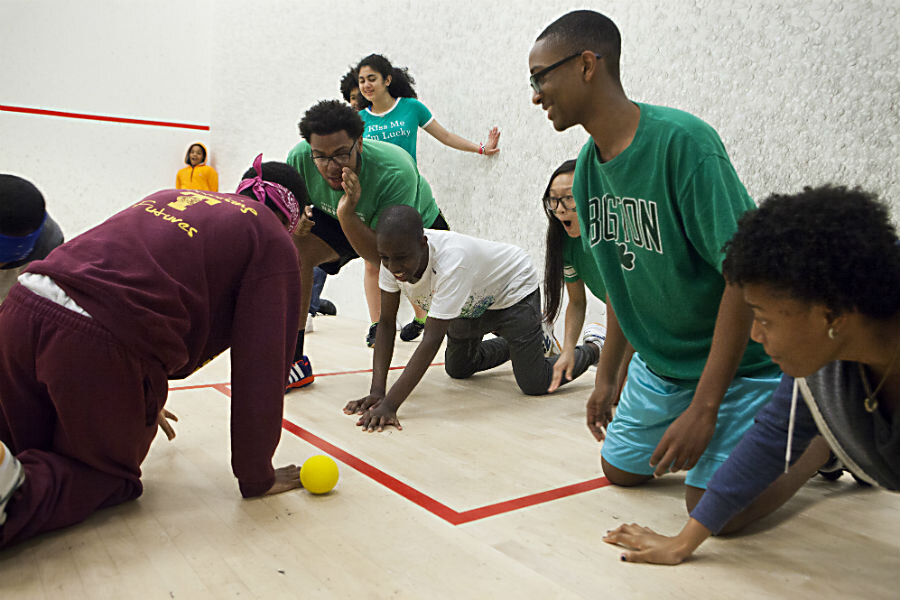How SquashBusters uses sport to transform young lives
Loading...
| Boston
The facility is hard to find, tucked away in the midst of a multistory parking garage in central Boston. You find yourself walking in circles, crossing railway bridges, and wandering through college campuses, wondering whether this is already some kind of test of your persistence, your determination.
But when you do locate it, and you duck inside, you have little doubt that you are indeed in the right place. Screams and shouts of countless teenagers echo through the arching entrance hall, demanding your attention but defying your efforts to pinpoint the source.
Rescuing you from your disorientation, a staff member comes and whisks you up a stairwell. The clamor grows. A door is opened, you find yourself ushered through, and the noise is near deafening.
Before you lies a series of squash courts, filled with groups of children, all engrossed in an array of games, though none of them squash. Today is no normal session, you are told. Today is end-of-year "Olympics."
This is SquashBusters, an after-school youth program that yes, includes squash, as well as academics and community service. Each student engages in the sport at least three times a week between September and June, and participates in 70 homework help sessions and three community service projects each year. There is also extensive college preparation and placement assistance.
The organization's mission is to use squash as a means to better the lives of inner-city kids, to give them access to opportunities they otherwise would have struggled to find.
“Squash had a huge effect on my life,” says Greg Zaff, founder and chief executive officer of SquashBusters. “But nobody had ever heard of the game apart from rich white people. I thought that was a shame, absurd.”
More than two decades ago, Mr. Zaff took a graduate program at the Harvard Kennedy School in Cambridge, Mass., and he wrote a paper entitled “Bringing Squash Down from the Ivory Tower.” It was about a plan for an urban squash program.
Many were the doubters, people who said the sport would hold no appeal, but by 1996, Zaff had put together a program and had 24 students enrolled.
“What I learned is kids don’t [care] about where a sport comes from,” he says. “What matters is, are they having fun? Do they like and respect the people?”
Described by the BBC as a "game that requires skill, speed and supreme fitness," squash is played on an indoor court, enclosed on all sides. The aim is for two players to use their long, slender rackets to pound a small rubber ball against the front wall until one of them fails to return it.
But the sport is only part of the SquashBusters picture. Between 2003 and 2015, 99 percent of the organization's graduates enrolled in college, compared with approximately 70 percent for Boston Public Schools. And equally important, if not more so, is how SquashBusters nurtures the students’ character, their well-being, their integrity.
“SquashBusters helped me establish self-discipline, self-control, literally across-the-board anger management,” says Carlos Richardson, a 26-year-old graduate of the program. “Sometimes I feel like if it wasn’t for SquashBusters ... The trend that my family followed was so dark, I feel like I might legit be in jail or dead now.”
Mr. Richardson says it laid the foundation for the business he has since set up, teaching him the value, and the art, of networking – something that was integral to transforming his ideas from vision to substance.
Richardson personifies what Zaff calls “inbuilt levels of mentoring,” whereby older students and successful SquashBusters graduates exemplify to the younger members what they can achieve, the kind of people they can become.
Many of the people who lead SquashBusters activities are themselves former, or even current, enrollees in the program. It is this sense of family, where “everyone really cares for each other,” that participants find so appealing, explains 16-year-old Heyssis Castillo.
“At first I was, like, what is this? This is the weirdest thing I’ve seen in my life!” says Heyssis, speaking of the time when SquashBusters visited her middle school, gave a demonstration, and handed out rackets.
That was four years ago, and now she describes the program as “like a second home.” She says she has introduced squash to students at her new school, few of whom knew what it was.
In Boston, SquashBusters has a shiny new facility, built in partnership with Northeastern University and serving 140 current program participants, Grades 7 through 12. Four years ago, the organization started a satellite program in Lawrence, Mass., and Zaff says 20 such programs are now spread across the country, though only Lawrence and Boston have any official affiliation.
There are challenges, not least funding – Zaff says $2 million are needed each year, compared with the $70,000 that sufficed in SquashBusters’ inaugural year – and the fact that so much of what the program achieves is difficult to measure. It is no easy task to quantify how a child feels more cared for, safer, more optimistic, Zaff explains.
Yet in conversations with the students, it seems clear that this is a big part of what SquashBusters provides.
“I love how it’s like a getaway,” Heyssis says. “Whatever else goes on in my life, I can literally come here and feel at ease.”






